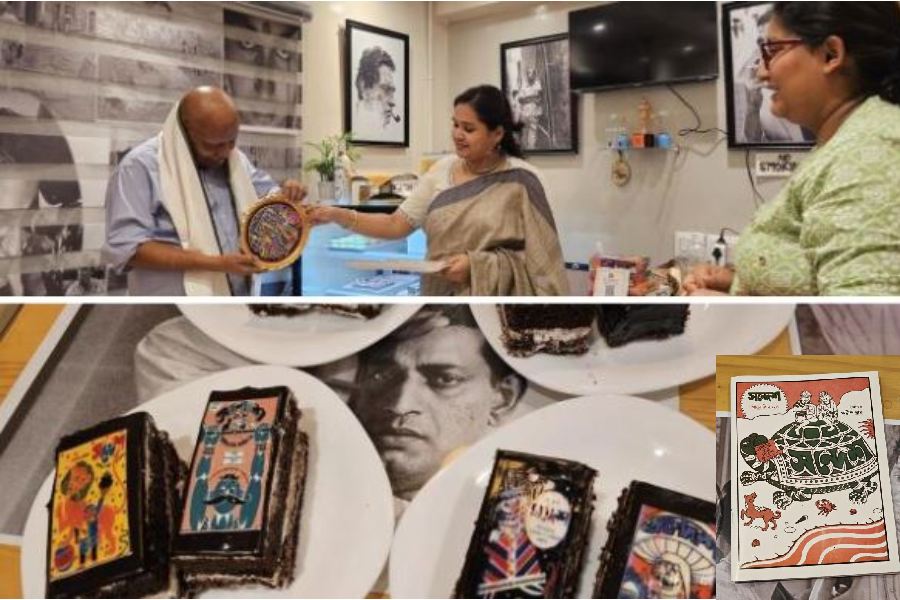Sandesh-themed pastries and stories of Sandesh. There were twin treats on offer for those who gathered at L’Ray Treat in BE Block, New Town, for an evening with Amitananda Das, the publisher of the children’s magazine founded by Upendrakishore Roychowdhury, printed by Sukumar Roy and revived by Satyajit Ray. Das is Roychowdhury’s great-grandson from his daughter Punyalata Chakraborty’s side.
The evening was planned as an advance commemoration of Satyajit Ray’s birth anniversary on May 2.
“I was 14 when Satyajit Ray revived Sandesh, in 1961,” recalled Amitananda. The magazine, launched in 1913, had shut down in 1934. On revival, it operated out of a single room in the Communist Party of India (CPI) party office at 172 Dharamtala Street. “Poet Subhas Mukhopadhyay was made the executive editor, with a monthly salary of Rs 500. Goopi (Tapen Chatterjee, who played the role in the Goopi-Bagha films) was in ad sales.”
Funds crunch
But it was not commercially viable. “After suffering heavy losses in 1961-62, Ray told friends that he could not sustain Sandesh under the proprietorship model. Mukhopadhyay’s salary too could not be supported through the magazine’s cover price of 75paise. So a non-profit literary cooperative society was formed with the name Sukumar Sahitya Samavay Samiti in January 1963 in which Ray’s colleagues like Soumitra Chatterjee and Aparna Sen picked up shares. As a further cost-cutting measure, the magazine shifted to our Rashbehari Avenue residence in early 1964. Leela Majumdar offered to work as honorary joint editor while my father (Asokananda Das) became the honorary publisher. The initial screening of writings was done by my mother and passed on to Leela Majumdar from whom the manuscripts went to Satyajit Ray. The final editing was done by Ray himself,” he recalled.
The magazine was a 64-page edition for 10 months while for Puja, a special issue came out combining two months. In 1971, Amitananda, who had just completed M.Tech, joined the board. “My father looked after production while I did the budgeting and some writing.” Regular authors Sisir Majumdar, Manjil Sen, Rebanta Goswami and Pranab Mukopadhyay also gradually became board members.
Financial constraints were there all along. Relief, when it came, was temporary. Bharat Shumsher Jang Bahadur Rana of Nepal, the producer of Seemabaddho, granted an amount in advertisements with which losses for a year were made up. “Yet Ray did not share his financial difficulties at Sandesh with most people as he was wary of being taken advantage of in other ways. He made such good use of his time that he maintained a notebook of which stories took him how many days to write. Sandip has written on that in our Feluda 30 edition,” Das said.
While Satyajit Ray would regularly come for the Sandesh meetings, young Amitananda also got to visit his sets a few times. “He was shooting Jalsaghar at a studio in Tollgunge. The scene was a bearer serving a glass of sherbet to Chhabi Biswas, the protagonist. It was an outdoor scene being shot indoors. Suddenly he called “Cut. Sky diye ke hnete gyalo?” A cloud had been drawn on a canvas strategically placed outside the skylight but someone had walked in between the two, causing his shadow to be cast on the cloud,” he explained, drawing a smile on the faces of audience members. Amitananda also recalled attending the shoot of Jai Baba Felunath when the scene before the knife-throwing scene was shot. “The cinematographer was only handling the technical aspects like checking the light on the light meter. The camera would be handled by Ray himself.”
The discussion then veered on possible ways of keeping Sandesh relevant for young readers of today. Everyone was treated to pastries with covers of Sandesh illustrated by Ray himself and baked by Ishita Dasgupta, the in-house baker at L’Ray Treat.
